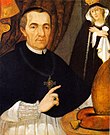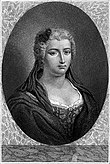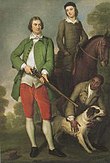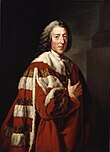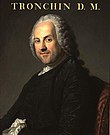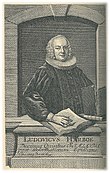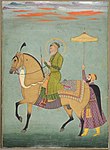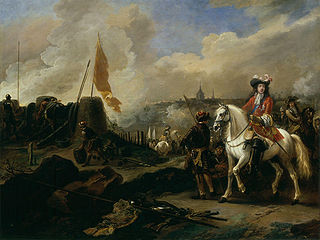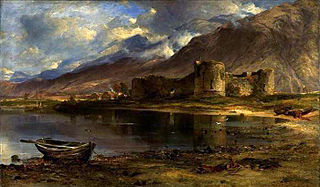Events
1700
January–March
- January 1 – Protestant nations in Western Europe, except England, start using the Gregorian calendar. Catholic nations have been using the Gregorian calendar since its introduction in 1582 by Pope Gregory XIII.
- January 1 (Julian) (January 11, Gregorian) – The Tsardom of Russia begins numbering its calendar from the birth of Christ (Anno Domini), instead of since the Creation (Anno Mundi).
- January 26 – At approximately 9 p.m., the Cascadia earthquake occurs in the Pacific Northwest, with an estimated moment magnitude of 8.7–9.2. This megathrust earthquake ruptures about 1,000 kilometers (620 miles) of the Cascadia Subduction Zone and causes a tsunami, that strikes the coast of Japan approximately 10 hours later.
- February 3 – The 'Lesser Great Fire' destroys a substantial part of central Edinburgh, Scotland. [1]
- February 12 – The Great Northern War begins with a joint invasion of Swedish territory in Germany and Latvia, by Denmark and Poland/Saxony. Sweden has control of the Baltic Sea and holds territory that includes Finland, Estonia, Latvia and parts of northern Germany. To challenge its power, an alliance is formed between Tsar Peter I of Russia, King Frederick IV of Denmark and Augustus II the Strong, King of Poland and Elector of Saxony. Sweden's ruler is the militaristic Charles XII, known as the "Swedish Meteor".
- February 27 – The island of New Britain is discovered by William Dampier, in the western Pacific. [2]
- March 1 (Gregorian) – Protestant Germany and Denmark–Norway adopt the Gregorian calendar.
- March 1 (Swedish), March 11 (Gregorian), February 29 (Julian) – The Swedish calendar is adopted.
- March (early) – William Congreve's comedy The Way of the World is first performed in London. [3] [4] [5]
- March 3 – Shivaji II accedes to the throne of the Maratha Empire as the 4th Chhatrapati after his father Rajaram I's death.
- March 24 – The Treaty of London is signed between France, England and the Dutch Republic. [6]
April–June
- April 15 – The coronation of King Frederick IV of Denmark takes place at Frederiksborg Castle in Copenhagen.
- April 18 – Hungarian freedom activist Ferenc Rákóczi is arrested by Austrian authorities and charged with sedition. Imprisoned near Vienna and facing a death sentence, he escapes and later leads the overthrow of the Habsburg control of Hungary.
- April 21 – In India, the siege of the fortress of Sajjangad (located in the Maharashtra state) is begun by an army led by Fateullahakhan. The fortress falls on June 6.
- April – Fire destroys many buildings in Gondar, the capital of Ethiopia, including two in the palace complex.
- May 5
- Within a few days of poet John Dryden's death in London (May 1 O.S.), his last written work ( The Secular Masque ) is performed as part of Vanbrugh's version of The Pilgrim .
- William Penn begins monthly meetings for blacks advocating emancipation.[ citation needed ]
- May – In Rhode Island (American colony), Walter Clarke, three-term former Governor of the Colony of Rhode Island and Providence Plantations, is elected deputy governor for the second time, serving under his brother-in-law Samuel Cranston.
- June 8 (May 28 O.S.) – The legislature for the Province of Massachusetts Bay (the modern-day Commonwealth of Massachusetts in the United States) passes into law "An Act against Jesuits & Popish Priests" making a finding that Roman Catholic clerics have attempted to incite American Indians into a rebellion against the Crown, and declaring "That all and every Jesuit, Seminary Priest, Missionary, or other Spiritual or Ecclesiastical Person made or ordained by any Authority, Power or Jurisdiction derived, challenged or pretended from the Pope or See of Rome, now residing within this Province or any part thereof, shall depart from and out of the same, at or before the tenth day of September next, in this present year, One Thousand and Seven Hundred." [7] The Province of New York enacts similar legislation later in the year.
July–September
- July 11 – The Prussian Academy of Sciences is founded, with Gottfried Leibniz as president. [8]
- July 24 – Charles XII of Sweden counter-attacks his enemies by invading Zealand (Denmark), assisted by an Anglo-Dutch naval squadron under Sir George Rooke, rapidly compelling the Danes to submit to peace. [9]
- July 30 – Eleven-year-old Prince William, Duke of Gloucester, dies of "a malignant fever" at Windsor Castle, leaving the Protestant succession to the British throne in doubt.
- August 18 (August 7 O.S.) – The Peace of Travendal is concluded between the Swedish Empire, Denmark–Norway and Holstein-Gottorp in Traventhal. On the same day, Augustus II, King of Poland, and Peter the Great, Tsar of Russia, enter the war against Sweden.
- September 6 – Edmond Halley returns to England after a voyage of almost one year on HMS Paramour, from which he has observed the Antarctic Convergence, [10] and publishes his findings on terrestrial magnetism in General Chart of the Variation of the Compass.
- September 12 – Antioh Cantemir is deposed as the voivode of Moldavia and replaced by his predecessor Constantine Ducas.
- September 27 – Pope Innocent XII dies at the age of 85 after a tenure of more than nine years. Fabrizio Spada, the Cardinal Secretary of State, assumes administration of the Roman Catholic Church in order to oversee the election of a new Pope.
- September – A Russian army invades Swedish Estonia, and besieges the town of Narva. [11]
October–December
- October 3 – The Battle of Jouami' al-Ulama takes place in Algeria with a surprise attack and ambush on the army of Murad III Bey of Tunis by two Algerian defenders, Hadj Mustapha, Dey of Algiers and Ahmed ben Ferhat, Beylik of Constantine.
- October 16 – Adrian, Patriarch of All Russia, dies after more than 10 years as head of the Russian Orthodox Church. He is replaced by the hand-picked choice of Tsar Peter the Great with the appointment of Simeon Ivanovich Yavorsky as Patriarch Stefan.
- November 1 – Charles II, the last Spanish king of the House of Habsburg, dies at the Royal Alcazar of Madrid aged 38, leaving no children; his last will makes Philip of Anjou his heir.
- November 15 – Louis XIV of France accepts the Spanish crown on behalf of his grandson Philip of Anjou of the House of Bourbon, who becomes Philip V of Spain (reigning for 44 years – with a short break – to 1746), thus triggering the War of the Spanish Succession (1701–1714). [12]
- November 18 – Lithuanian Civil War: Battle of Valkininkai – The anti-Sapieha coalition is victorious.
- November 23 – Cardinal Giovanni Francesco Albani, having been ordained as a Roman Catholic priest only two months earlier, is elected by the Papal conclave to succeed Pope Innocent XII, and becomes the 243rd pope, taking the name of Clement XI.

- November 30 (November 19 O.S.; November 20 Swedish calendar) – Battle of Narva in Estonia: Having led his army of 8,000 on a forced march from Denmark to Estonia, Charles XII of Sweden routs the huge Russian army.
- December 8 – The formal coronation of Pope Clement XI takes place in Rome.
- December 28 – Laurence Hyde, 1st Earl of Rochester, Lord President of the Council in charge of the Privy Council, is appointed to the additional job of Lord Lieutenant of Ireland, the highest Crown official in charge of administration of Ireland, .
- December 30 (December 19, O.S.) – The 4th Parliament of King William III in England is dissolved and new elections are ordered by the King.
Date unknown
- Mission San Xavier del Bac is founded in New Spain near Tucson, as a Spanish Roman Catholic mission. Its location had first been scouted by the Spanish in 1692. [13]
- An inventory made for the House of Medici of Florence is the first documentary evidence for a piano, invented by their instrument keeper Bartolomeo Cristofori.
- An English translation of the novel Don Quixote , "translated from the original by many hands and published by Peter Motteux", begins publication in London. While popular among readers, it will eventually come to be known as one of the worst translations of the novel, totally betraying the spirit of Miguel de Cervantes's masterpiece. [14]
- The value of sales of English manufactured products to the Atlantic economy is £3.9 million.
- Approximate date – Lions become extinct in Libya.
1701
January–March
- January 12 – Parts of the Netherlands adopt the Gregorian calendar.
- January 18 – The electorate of Brandenburg-Prussia becomes the Kingdom of Prussia, as Elector Frederick III is proclaimed King Frederick I. Prussia remains part of the Holy Roman Empire. It consists of Brandenburg, Pomerania and East Prussia. Berlin is the capital. [15]
- January 28 – The Chinese storm Dartsedo.
- February 17 (February 6, 1700 O.S.) – The 5th Parliament of King William III is assembled. Future Prime Minister Robert Walpole enters the Parliament of England, and soon makes his name as a spokesman for Whig policy.
- March 8 – Mecklenburg-Strelitz is created as a north German duchy.
- March 9 – Safavid troops retreat from Basra, ending a three year occupation. [16]
April–June
- April 21 – In Japan, the young daimyō Asano Naganori is ordered to commit seppuku (ritual suicide). A group of 47 samurai of his service begin planning to avenge his death.
- May 23 – After being convicted of murdering William Moore, and for piracy, Captain William Kidd is hanged in London.
- June 24 – The Act of Settlement 1701 is passed by the Parliament of England, to exclude the Catholic Stuarts from the British monarchy. Under its terms, King William III, childless, will be succeeded by Queen Mary II's sister Princess Anne and her descendants. If Anne should have no descendants, she will be succeeded by Sophia of Hanover and her descendants (hence the Hanoverian Succession in 1714).
- June 28 – The Myrton baronets, a British nobility title is created. [17]
July–September
- July 9
- The Battle of Carpi, the first skirmish in the War of the Spanish Succession, takes place in Italy when French troops under the command of Nicolas Catinat are attacked by Austrian forces led by Prince Eugene of Savoy. [18]

- Crossing of the Düna: Following his victories over Denmark-Norway and Russia in 1700, Charles XII of Sweden escalates the conflict in the Great Northern War by an invasion of Poland. The Swedish defeat the army of Saxony (then in personal union with Poland) at the River Dvina.
- July 24 – A French emporium named Fort Ponchartrain is founded along the west side of the Detroit River in North America, and later becomes the site of the city of Detroit.
- August 4 – The Great Peace of Montreal is signed, ending 100 years of war between the Iroquois Confederacy and New France, and its Huron and Algonquian allies. Formerly allied with the English, the treaty assures the Iroquois will be neutral, if France and England ever resume hostilities.
- September 16 – Deposed King James II of England (James VII of Scotland) dies in exile, at the Château de Saint-Germain-en-Laye in France. His supporters, the Jacobites, turn to his son James Francis Edward Stuart (later called "The Old Pretender"), whom they recognise as James VIII and III. Louis XIV of France, the Papal States and Spain also recognise him as the rightful heir. [19]
October–December
- October 9 – The Collegiate School of Connecticut (later renamed Yale University) is chartered in Old Saybrook, Connecticut.
- November 2 – King Philip V of Spain marries for the first time, to 13-year-old Maria Luisa Gabriella of Savoy, who serves as Queen Consort until her death from tuberculosis at the age of 25.
- November 11 (O.S., November 22 N.S.) – The House of Commons of England is dissolved by King William III and new elections are called for all 531 seats. [20]
- December 29 (O.S., January 9, 1702 N.S.) – The Battle of Erastfer takes place near what is now Erastvere in Estonia, as a large Russian force commanded by Boris Sheremetev invades Swedish Livonia and overwhelms a smaller force led by Wolmar Anton von Schlippenbach in the first significant Russian victory in the Great Northern War.
Date unknown
- English agriculturalist Jethro Tull invents a drill for planting seeds in rows.
- The Philharmonic Society (Academia Philharmonicorum) is established in Ljubljana, Slovenia.
1702
January–March
- January 2 – A total solar eclipse is visible from the southern Pacific Ocean.
- January 12 – In North America, ships from Fort Maurepas arrive at Twenty-Seven Mile Bluff, to build Fort Louis de la Mobile (future Mobile, Alabama), to become the capital of French Louisiana.
- February 1 – The Duc de Villeroy, commander of the French Army, is taken as a prisoner of war by the Austrian Army during the Battle of Cremona
- March 3 (February 20 O.S.) – King William III of England is fatally injured in an accident when he is thrown from his horse, "Sorrel", while riding in Hampton Court Park near London. Already in poor health before the accident, he dies from his injuries 16 days later at the age of 51. [21]
- March 14 – An earthquake in the middle of the Calore valley in Italy, east of Benevento, kills 400 people.
- March 19 (March 8 Old Style) – Princess Anne Stuart, daughter of the late King James II and younger sister of his successor, Mary II of England (who had reigned jointly with her husband, William III, as "William and Mary" until her death in 1694), ascends the English, Scottish and Irish thrones upon William's death. In her first speech to the English Parliament, made three days later, she tells the assembly "As I know my heart to be entirely English, I can very sincerely assure you there is not anything you can expect or desire from me which I shall not be ready to do for the happiness and prosperity of England." [22] Anne is the mother of 17 children by her husband, Prince George of Denmark and Norway, but none will survive childhood, and she will die without an heir, bringing an end to the reign of the House of Stuart and enabling the Hanoverian Succession. After the death of William, the States General of the Netherlands do not appoint a new stadtholder, and so the Dutch Republic becomes a true republic again.
- March 22 (March 11 Old Style) – The first regular English-language national newspaper, The Daily Courant , begins publication [2] on Fleet Street in the City of London; it covers only foreign news.
- March 24 – Battle of Darsūniškis: The Swedish army of about 240 men, under the command of Alexander Hummerhielm, is defeated by the Polish–Saxon army of 6,000 men, under Michał Serwacy Wiśniowiecki.
April–June
- April 3 – The Dutch East India Company ship Merestein strikes rocks and sinks in Saldanha Bay off Jutten Island, Africa with the loss of 101 of the 200 people on board.
- April 14 – Volcanic eruption of Changbaishan volcano (also known as Paektu Mountain) takes place.
- April 15 – The British Province of New Jersey, encompassing all of the modern-day U.S. state of New Jersey and portions of New York, is created as proprietary owners in the provinces of East Jersey and West Jersey surrender their rights to the Crown. [23]
- April 20 – Comet C/1702 H1 is discovered and passes within 0.0435 AU (a little more than four million miles or 6.5 million km) of the Earth.
- April 24 – The first two missionaries from the Society for the Propagation of the Gospel in Foreign Parts set sail from England to North America.
- May 5 – Globular cluster Messier 5 (M5, NGC 5904) is discovered by Gottfried Kirch and his wife Maria Margarethe.
- May 6 – Cloudesley Shovell is promoted to full admiral in the English navy.
- May 14 (N.S.) – War of the Spanish Succession: War is declared on France by the Grand Alliance (Kingdom of England, Dutch Republic and Holy Roman Empire).
- May 15 (May 4 O.S.) – King Charles XII of Sweden and his troops walk unopposed into Warsaw after troops capture the city. [24]
- May 16 – Much of the city of Uppsala, Sweden is destroyed by fire.
- May 19 – Over 90% of the city of Bergen, Norway is destroyed and reduced to ashes in a Great Fire.
- June 2 – English General John Churchill, later the Duke of Marlborough, takes command of the alliance of English, Dutch and German troops in the War of the Spanish Succession. [25]
- June 11 – Anglo-Dutch forces skirmish with French forces before the walls of Nijmegen and prevent its fall. [26]
- June 15 – Queen Anne's Captain-General, John Churchill, forces the surrender of Kaiserswerth on the Rhine after a siege that began on April 18. [27]
- June 16 – the English East India Company founds a settlement on Pulo Condore (now called Côn Sơn Island) off the coast of southern Vietnam as an entrepôt for ships travelling between India and China.
- June 25 – The premiere of the opera L'Offendere per amore overo la Telesilla by Johann Joseph Fux takes place in Vienna.
July–September
- July 19 (July 8 O.S.; July 9 Swedish calendar) – Great Northern War – Battle of Klissow: Charles XII of Sweden decisively defeats the Polish–Lithuanian-Saxon army.
- July 23 – The first performance of the opera Médus, roi des Mèdes by François Bouvard takes place at the Paris Opera.
- July 24
- Camisard hostilities begin in France with the assassination at le Pont-de-Montvert of a local embodiment of royal oppression, François Langlade, the Abbé of Chaila. [27]
- A total eclipse of the sun is visible on a path crossing the northern Pacific Ocean and Central America.
- July 30 (July 19 O.S.; July 20 Swedish calendar) – Great Northern War – Battle of Hummelshof: Russia defeats Sweden.
- August 11 – Great Northern War: Częstochowa, Poland, is captured by the Swedish army.
- September 19 – Jupiter occults Neptune.
- September 25 – General John Churchill forces the surrender of Venlo on the Meuse River. [27]
October–December
- October 1 – The founding deed of the University of Wrocław is signed by the Holy Roman Emperor Leopold I of the House of Austria, King of Hungary and Bohemia.
- October 7 – Russian troops besiege the Swedish fortress of Nöteborg, and capture it after 15 days.
- October 12 – Sir George Rooke fails in his initial attempt to take Cadiz, but captures a Spanish treasure fleet and destroys French and Spanish warships. [28]
- October 14 – The Battle of Friedlingen takes place between France and the Holy Roman Empire.
- October 18 – Battle of Flint River: Spanish and Apalachee Indian forces fail in their attack against Creek Indians, supported by English traders, in what is now the state of Georgia.
- October 19 – The opera Der Sieg der fruchtbaren Pomona by Reinhard Keiser is premiered at the Hamburg Opera for the birthday of King Frederick IV of Denmark.
- October 23
- Battle of Vigo Bay: English and Dutch forces capture the defended harbor of Cádiz.
- Churchill forces the surrender of Liège.
- October 27 – English troops plunder St. Augustine, Spanish Florida.
- October 28 – Sieur Juchereau, Lieutenant General of Montréal, establishes the first trading post on the Wabash River in order to trade Buffalo hides with American Indians. The site of the trading post may be the modern-day location of Vincennes, Indiana.
- November 7 – The first performance of the opera Tancrède by André Campra takes place at the Théâtre du Palais-Royal in Paris.
- November 10 – Queen Anne's War in North America: The Siege of St. Augustine opens; English forces besiege St. Augustine, Spanish Florida.
- November 15 – The opera La Clemenza d'Augusto by Johann Joseph Fux is premiered in Vienna.
- November 22 – The Dutch East India Company pinnace Amsterdam founders en route to Basra from Bombay during a storm. All hands are lost.
- December 14 – John Churchill is created duke of Marlborough.
- December 30 – The Siege of St. Augustine in Spanish Florida is lifted.
Date unknown
- The travel diary Oku no Hosomichi (meaning "Narrow road to/of the interior"), a major work of haibun by the Japanese poet Matsuo Bashō and one of the major texts of Japanese literature of the Edo period, is published eight years after Bashō's death.
- Delaware is designated a separate colony.
- Richard Bentley at Cambridge in England introduces the first written (as opposed to oral) competitive examinations in a Western university. [29]
1703
January–March
- January 9 – The Jamaican town of Port Royal, a center of trade in the Western Hemisphere and, at the time, the largest city in the Caribbean, is destroyed by a fire. British ships in the harbor are able to rescue much of the merchandise that has been unloaded on the docks, but the inventory in marketplaces in town is destroyed. [30]
- January 14 – 1703 Apennine earthquakes: The magnitude 6.7 Norcia earthquake affects Central Italy with a maximum Mercalli intensity of XI (Extreme). With a death toll of 6,240–9,761, it is the first in a sequence of three destructive events.
- January 16 – 1703 Apennine earthquakes: The magnitude 6.2 Montereale earthquake causes damage at Accumoli, Armatrice, Cittareale, and Montereale, with a maximum Mercalli intensity of VIII (Severe).
- January 30 (December 14 of previous year in the Chinese calendar) – In Japan, Forty-seven rōnin assassinate daimyō Kira Yoshinaka, the enemy of their former lord Asano Naganori, at his own mansion as a vengeance; 46 of the 47 samurai commit seppuku, a ritual suicide on March 20 (February 4 in the Chinese calendar).
- February 2 – 1703 Apennine earthquakes: The magnitude 6.7 L'Aquila earthquake affects Central Italy, with a maximum Mercalli intensity of X (Extreme). In the final large event (an example of Coulomb stress transfer), damage occurs as far distant as Rome, with landslides, liquefaction, slope failures and at least 2,500 deaths.
- February 20–March 10 – War of the Spanish Succession: Siege of Kehl – French forces under the command of the Duc de Villars capture the fortress of the Holy Roman Empire at Kehl, opposite Strasbourg on the Rhine.
- February – Soldiers at Fort Louis de la Mobile celebrate Mardi Gras in Mobile, starting the tradition for Mobile, Alabama.
- March 1 – The Recruiting Act 1703 goes into effect in England, providing for the forcible enlistment of able-bodied but unemployed men into the English Army and Royal Navy in order to fight in Queen Anne's War in North America. The Act expires at the end of February 1704.
- March 15 – The landmark English court case of Rose v Royal College of Physicians is decided by the Court of Queen's Bench, beginning the end of the monopoly that the Royal College of Physicians has over the practice of medicine.
- March 19 – The Siege of Guadeloupe begins as an English expeditionary force, led by Christopher Codrington and Hovenden Walker, lands at Basse-Terre and attempts to take over the French-held island. The English fleet departs on May 15 after being unable to capture Guadeloupe. [31]
- March 20 – The Akō incident occurs in Japan as 46 independent samurai (rōnin) carry out an order of seppuku (ritual suicide) for the revenge murder of a high-ranking government official, Kira Yoshinaka, on January 30. The punishment is given by the shōgun, Tokugawa Tsunayoshi. The story continues to be dramatized more than 300 years later in Chūshingura theater, novels and film.
- March 21 – Jeanne Guyon is freed in Paris after more than seven years imprisonment for heresy in the Bastille.
April–June
- April 21 – The Company of Quenching of Fire (i.e., a fire brigade) is founded in Edinburgh, Scotland.
- May 26 – Portugal joins the Grand Alliance.
- May 27 (May 16 OS) – The city of Saint Petersburg, Russia is founded, following Peter the Great's reconquest of Ingria from Sweden during the Great Northern War.
- June 15 – Rákóczi's War of Independence: Hungarians rebel under Prince Francis II Rákóczi.
- June 19 – Bavarian troops, who during the so-called Bavarian Rummel have invaded Tyrol, besiege Kufstein. Fires break out on the outskirts that engulf the town, destroy it and reach the powder store of the supposedly impregnable fortress. The enormous gunpowder supplies explode and Kufstein has to surrender on 20 June. This same day the Tyrolese surrender in Wörgl; two days later Rattenberg is captured and Innsbruck is cleared without a fight on 25 June.
- June – The completed Icelandic census of 1703 is presented in the Althing, the first complete census of any country.
- June 30 – Battle of Ekeren: The French surround a smaller Dutch force, which however breaks out and retires to safety.
July–September
- July 26 – After their victories at the Pontlatzer Bridge and the Brenner Pass, Tyrolese farmers drive out the Bavarian Elector, Maximilian II Emanuel, from North Tyrol and thus prevent the Bavarian Army, which is allied with France, from marching on Vienna during the War of the Spanish Succession. This success, at low cost, is the signal for the rebellion of the Tyrolese against Bavaria, and Elector Maximilian II Emanuel has to flee from Innsbruck. The Bavarian Army withdraws through Seefeld in Tirol back to Bavaria.
- July 29 – 31 – Daniel Defoe is placed in a pillory in London, then imprisoned for four months for the crime of seditious libel after publishing his satirical political pamphlet The Shortest Way with the Dissenters (1702) (his release is granted in mid-November).
- August 23 – Edirne event: Sultan Mustafa II of the Ottoman Empire is dethroned.
- September 7 – War of the Spanish Succession: The town of Breisach is retaken for France by Camille d'Hostun, duc de Tallard.
- September 12 – War of the Spanish Succession: Habsburg Archduke Charles is proclaimed King of Spain, but never exercises full rule.
October–December
- October 11 – Nine Roman Catholic residents of the French village of Sainte-Cécile-d'Andorge are massacred by a mob of more than 800 French Huguenot Protestants, the Camisards. A reprisal against Protestants in the nearby village of Branoux is made less than three weeks later.
- October 23 – Hannah Twynnoy, a 24-year-old barmaid in Malmesbury, Wiltshire, becomes the first person to be killed in Great Britain by a tiger. While working at the White Lion Inn, where a group of wild animals is on exhibit, she is mauled after bothering the tiger.
- October 30 – More than 47 Huguenots in the village of Branoux-les-Taillades are massacred by Roman Catholic vigilantes in reprisal for the October 11 attack on nearby Sainte-Cécile, slightly more than two miles away.
- November 15
- War of the Spanish Succession: Battle of Speyerbach (in modern-day Germany) – The French defeat a German relief army, allowing the French to take the besieged town of Landau two days later, for which Tallard is made a Marshal of France.
- Rákóczi's War of Independence: Battle of Zvolen (in modern-day Slovakia) – The Kurucs defeat the Austrians and their allies (Denmark, Hungary and the Serbs).
- November 19 – The Man in the Iron Mask dies in the Bastille.
- November 26 – Great Storm of 1703: A cyclone strikes the British Isles, destroying hundreds of buildings and killing thousands of men at sea.
- November 30 – Isaac Newton is elected president of the Royal Society in London, a position he will hold until his death in 1727.
- December 7 – 10 (November 26–29 O.S.) – The Great Storm of 1703 ravages southern England and the English Channel, killing at least 8,000, mostly at sea. The Eddystone Lighthouse off Plymouth is destroyed in the storm together with its designer Henry Winstanley. [32]
- December 27 – Portugal and England sign the Methuen Treaty, which gives preference to Portuguese wines imported into England.
- December 28 – Ahmed III succeeds the deposed Mustafa II as Ottoman Emperor.
Date unknown
- French-born imposter George Psalmanazar arrives in London.
- Between 1702 and 1703, an epidemic of smallpox breaks out in Quebec, in which 2,000-3,000 people die (300-400 in Quebec City). [33]
1704
January–March
- January 7 – Partial solar eclipse, Solar Saros 146, is visible in Antarctica.
- January 25 – 26 – Apalachee massacre: English colonists from the Province of Carolina, and their native allies, stage a series of brutal raids against a largely pacific population of Apalachee, in Spanish Florida.
- February 28 – Establishment of the first school open to African-Americans in New York City by Frenchman Elias Neau.
- February 29 – Raid on Deerfield (Queen Anne's War): French Canadians and Native Americans sack Deerfield, Massachusetts, killing over 50 English colonists.
- February – In America, Mardi Gras is celebrated with the Masque de la Mobile in the capital of Louisiana (New France), Mobile, Alabama.
- March 7 – War of the Spanish Succession: Prince Karl of Habsburg, brother of Joseph I, the Holy Roman Emperor and a pretender to the throne of Spain, arrives in Portugal on the English warship HMS Royal Katherine as part of George Rooke's English fleet sailing into Lisbon.
- March 23 – War of the Spanish Succession: The English Navy ships HMS Kent, HMS Bedford and HMS Antelope intercept two newly-built Spanish warships, Porta Coeli and Santa Teresa off of the coast of Cape Spartel, as the Spaniards attempt to sail into the Strait of Gibraltar. The two Spanish ships are captured after a seven-hour battle and taken toward Lisbon, but the Santa Teresa sinks along the way.
April–June
- April 21 – Battle of Biskupice: The Hungarians (Kurucs) win a costly victory over the Danes.
- April 24 – The first regular newspaper in the Thirteen Colonies of British North America, The Boston News-Letter , is published.
- May 19 – 23 – Vigorous Strombolian activity from Mount Vesuvius, Italy is recorded.
- May 28 – Battle of Smolenice: Kuruc rebels defeat the Austrian army and its allies.
- June 2 – Annular solar eclipse is visible from a region of the Southern Ocean between South Africa and Antarctica.
- June 13 – Battle of Koroncó: Austrians and their allies from Denmark, Prussia, Croatia, Germany and Vojvodina defeat the Kurucs.
- June 17 – Total lunar eclipse takes place, Saros series 125.
July–September
- July – Daniel Defoe documents the Great Storm of 1703 in England, with eyewitness testimonies, in The Storm .
- July 12 – Great Northern War – King Charles XII of Sweden forces the election of his ally Stanisław Leszczyński as King of Poland, in place of Augustus II the Strong.
- August 3 (July 23 Old Style) – War of the Spanish Succession – Gibraltar is captured from Spain, by English and Dutch forces under Sir George Rooke. [34]
- August 7 – Battle of Orford Ness.
- August 13 (August 2 OS) – War of the Spanish Succession – Battle of Blenheim: Allied troops under John Churchill, Earl of Marlborough and Prince Eugene of Savoy defeat the Franco-Bavarian army.
- August 24 (August 13 OS) – War of the Spanish Succession – The French and Anglo-Dutch fleets clash off Málaga, causing heavy casualties on both sides, but without sinking any ships.
- September 8 – War of the Spanish Succession – The Twelfth Siege of Gibraltar by French and Spanish troops begins.
- September 12 – War of the Spanish Succession: The siege of the French-held German town of Landau, by Holy Roman Empire troops under the command of Ludwig Wilhelm von Baden-Baden begins and lasts for more than ten weeks before the French surrender on November 23. During the siege, the Holy Roman Emperor Joseph I visits the area in a newly-developed vehicle, a convertible horse-drawn carriage that has a removable roof. The style of vehicle itself is later called a "landau".
- September 28 – Damat Hasan Pasha, Grand Vizier of the Ottoman Empire, is removed from office by Ottoman Sultan Ahmed III, and replaced by Kalaylikoz Ahmed Pasha.
October–December
- October 24 – A peace treaty is signed between Prince Ferenc Rákóczi of Transylvania, and representatives of the Holy Roman Emperor, Leopold I at Schemnitz (now the Slovakian town of Banská Štiavnica)
- October 28 – Great Northern War: The Battle of Poniec takes place as King Charles XII leads Swedish troops in pursuit of the Saxon Army commanded by General Johann von der Schulenburg. The Swedes are forced to retreat despite surrounding the Saxons, and Schulenburg's troops escape.
- November 11 – Twelfth Siege of Gibraltar: A Spanish Bourbon special forces battalion, guided by Simon Susarte, scales the steepest side of the Rock of Gibraltar in an attempt to surprise the British defenders, and kills the English sentries who have been manning the lookout. The attack is foiled the next day when a drummer boy, who was bringing food to the sentries, spots the invaders and raises the alarm.
- November 26 – The inauguration of the newly built Kastelskirken takes place in Copenhagen, Denmark.
- November 27 – Annular solar eclipse is visible through Kazakhstan, Kyrgyzstan, eastern China, Myanmar and northern Philippines.
- December 6 – Battle of Chamkaur: During the Mughal-Sikh Wars, an outnumbered Sikh Khalsa defeats a Mughal army.
- December 25 – The fall of the meteorite of Barcelona is seen and heard over distances up to hundreds of kilometres and is interpreted as a divine sign.
Date unknown
- Great Northern War: Russian troops under Tsar Peter the Great capture Tartu and Narva.
- The Sultanate of Brunei cedes its north-east territories to the Sultanate of Sulu.
- The lower three counties of the Province of Pennsylvania become the colony of Delaware.
- An earthquake strikes Gondar, Ethiopia.
- Tenerife's earliest recorded volcanic eruption takes place from three fissure emission centres: Siete Fuentes, Fasnia and Arafo.
- A Tale of a Tub , the first major satire by Jonathan Swift (written 1694–1697), is published in London, running through three editions this year.
- Isaac Newton publishes his Opticks . He also predicts that the world will end in 2060.
- The Students' Monument is built in Aiud, Romania.
- Chinese Rites controversy: Rome decrees that Roman ceremonial practice in Latin (not in Chinese) is to be the law for Chinese missions.
- Nerchinsky Zavod is founded in the Nerchinsko-Zavodsky District of Zabaykalsky Krai, Russia by Greek mining engineers.
- Thomas Darley purchases the bay Arabian horse Darley Arabian in Aleppo, Syria, and ships him to stud in England, where he becomes the most important foundation sire of all modern thoroughbred racing bloodstock.
- Giancomo Miraldi observes Martian polar ice caps as "white spots" at the Martian poles.
1705
January–March
- January 8 – George Frideric Handel's first opera, Almira , is premiered in Hamburg.
- January 31 – The Hester, a British 28-gun sailing ship with a crew of 70, is lost in Persia.
- February 7 – The Twelfth Siege of Gibraltar begins as Marshal René de Froulay de Tessé of the French Army supplements the Spanish forces of the Marquis of Villadarias and seizes control of a strategic fortress, the Round Tower, but the forces retreat after a counterattack kills 200 of their number in the retaking of the Tower
- February 25 – George Frideric Handel's opera Nero premieres in Hamburg. [35]
- February 26 – A French Navy fleet of 18 warships, commanded by Admiral Desjean, the Baron de Pointis arrives in the Bay of Gibraltar to aid the French and Spanish attempt to retake Gibraltar from England.
- March 8 – The Province of Carolina incorporates the town of Bath, making it the first incorporated town in present-day North Carolina. The town becomes the political center and de facto capital of the northern portion of the Province of Carolina, until Edenton is incorporated in 1722.
- March 14 – Queen Anne gives royal assent to the Alien Act 1705, setting a deadline of December 25, 1705, for Scotland's parliament to authorize negotiations for the union with England to create the Kingdom of Great Britain and, if Scotland fails to do so, to declare all Scots in England to be arrested and detained as illegal aliens until union is achieved. [36]
- March 31 (March 20 O.S.) – The Twelfth Siege of Gibraltar ends as a fleet of warships from the navies of England, Portugal and the Netherlands, commanded by English Admiral John Leake, arrives at the Bay of Gibraltar with 35 warships and English and Portuguese troops. In the battle that follows, five of the French Navy's ships are sunk and Admiral Desjean is seriously wounded, forcing the French and Spanish to retreat.
April–June
- April 5 – Anne, Queen of England dissolves the English House of Commons that had been elected in 1702, and orders new elections.
- April 9 – The Queen's Theatre opens in Westminster to serve as an opera house, premiering with Gli amori di ergasto ("The Loves of Ergasto"), an Italian language opera by German composer Jakob "Giacomo" Greber. It remains in operation for more than 300 years, becoming Her Majesty's Theatre.
- April 16 – Queen Anne of England honours Isaac Newton with a Knight Bachelor.
- May 5 – Joseph I succeeds his father Leopold I as the Holy Roman Emperor. [37]
- May 7 – Voting begins for 110 constituencies of the 513-member House of Commons of England (including Wales)
- June 6 – Voting ends in the election of the English House of Commons, with the Tories retaining their majority but losing 38 seats, while the Whigs gain 49 seats. The balance in the 513 seats is 260 for the Tories, 233 for the Whigs, 20 for other candidates.
- June 20 – The Pact of Genoa is signed by representatives of England and the Spanish Principality of Catalonia as a military alliance providing for English troops to be stationed in Catalonia as part of the War of Spanish Succession.
July–September
- July 11 – José de Grimaldo, the Marquis of Grimaldo, becomes the head of government of Spain after being appointed by King Philip V as the Secretary of the Universal Bureau
- July 14 – The newly-elected English House of Commons, last to serve before the union with Scotland that produces Great Britain, is opened by Queen Anne.
- July 15 – Al-Husayn I ibn Ali becomes the first Bey of Tunis, founding the Husainid Dynasty that rules Tunisia until the abolition of the monarchy in 1957
- July 18 – War of the Spanish Succession: At the Battle of Elixheim, near the city of Tienen (in modern-day Belgium), is fought, as an exhausted group of soldiers under the command of England's Duke of Marlborough kills 3,000 French troops under the command of the Duc de Valleroy, and forces the retreat of the others, breaking the "Lines of Brabant". Because his soldiers had marched all night and then fought the battle over a full day, Marlborough is unable to send them in pursuit of Villeroy's troops.
- July 20 – The planet Mercury transits Jupiter, as seen by astronomers from Earth. The event happens again on October 4, 1708, but will not be seen again from Earth until October 27, 2088
- July 26 – Great Northern War: At the Battle of Gemauerthof, fought in modern-day Latvia, Swedish forces under the command of General Adam Ludwig Lewenhaupt overwhelm a much larger force of Russian troops commanded by Count Boris Sheremetev, killing 2,000 Russians and wounding as many as 3,000.
- July 31 – The Battle of Warsaw is fought near Warsaw, Poland in the Great Northern War.
- August 16 – 18 – In an Atlantic tropical cyclone across Cuba and Florida, four ships are lost and there are many casualties.
- August 31 – September 5 – War of the Spanish Succession: The Siege of Zoutleeuw is carried out by the alliance of Dutch, English, Scottish and Holy Roman Empire troops against the French-held fortress of Zoutleeuw (in modern-day Belgium)
- September 17 – First Javanese War of Succession: On the island of Java in the Dutch East Indies (modern-day Indonesia), Pakubuwono I becomes the new Sultan of Martaram, capturing Kartosuro and deposing Sultan Amangkurat III.
- September 20 – Francis II Rákóczi is proclaimed as the ruler of Hungary by independence activists in Szécsény who are opposed to the rule of the Habsburg successor to Leopold I, the Holy Roman emperor Joseph I.
- September 24 (O.S.) – Stanisław Leszczyński is crowned as King of Poland.
October–December
- October 3 – Thirty-one people are killed in a colliery explosion at the Stony Flatt pit in Gateshead, Northumberland, England.
- October 4 (N.S.) – Stanisław Leszczyński is crowned Stanisław I of Poland.
- November – In Williamsburg, capital of the Colony of Virginia in America, construction of the Capitol Building is completed.
- November 5 – The Dublin Gazette of Ireland publishes its first edition.
- November 15 – Battle of Zsibó: The Austrian-Danish forces defeat the Kurucs (Hungarians).
- November 16 – An annular solar eclipse is visible in the southern Atlantic Ocean.
- November 23 – The premiere of the play Ulysses by Nicholas Rowe takes place in London.
- November 24 – An earthquake is recorded in Syria, northeast of Damascus.
- November 28 – The Treaty of Warsaw was concluded between the Swedish Empire and the faction of the Polish–Lithuanian Commonwealth loyal to Stanisław Leszczyński during the Great Northern War.
- December – The Sophia Naturalization Act is passed by the English Parliament, which naturalizes Sophia of Hanover and the "issue of her body" as English subjects.
- December 13 – In the Battle of Saint Gotthard, the Hungarian army is victorious.
- December 25 – In Munich, capital of Bavaria, 1,100 militiamen from the Oberland are killed during the Sendlinger Mordweihnacht, after a failed attempt to break through several gates and capture a depot to seize better weaponry; many men were slaughtered by German federal infantry and Hungarian Hussars, despite their capitulation to Austrian officers.
- December 26 – Fateh Singh and Zorawar Singh, sons of Guru Gobind Singh, are murdered by Wazir Khan for refusing to convert to Islam, and become hallowed martyrs in Sikhism.
- December 29 – The premiere of the play Idoménée by Prosper Jolyot de Crébillon takes place in Paris.
Date unknown
- Construction begins on Blenheim Palace, in Oxfordshire, England; it is completed in 1724.
- Taichung City, Taiwan is founded as the village of Dadun.
- With the interest paid from daimyō loans, the Konoike buy a tract of ponds and swampland, turn the land into rice paddies, and settle 480 households numbering perhaps 2,880 peasants on the land.
- The Shogunate confiscates the property of a merchant in Osaka "for conduct unbecoming a member of the commercial class". The government seizes 50 pairs of gold screens, 360 carpets, several mansions, 48 granaries and warehouses scattered around the country, and hundreds of thousands of gold pieces.
1706
January–March
- January 26
- War of Spanish Succession: The uprising by Bavarians against the occupation of the Electorate of Bavaria by Austrian troops ends after 75 days, and ends the plans of Maximilian, the Elector of Bavaria, to bring Bavaria under the rule of the House of Wittelsbach.
- Great Northern War – Battle of Grodno: A coalition of 34,000 Swedish and Polish troops besieges the then-Lithuanian city in the winter time, and clashes with 41,000 Russian and Saxon troops. After almost three months of fighting that lasts to April 10, Sweden takes control of the city, which is now located in Belarus.
- February 6 – The city of Albuquerque, New Mexico, is incorporated by governor Don Francisco Cuervo y Valdes as La Villa de Alburquerque in the Spanish colonial province of Santa Fe de Nuevo México in New Spain. Governor Cuervo sends a report on April 23 to the Spanish Crown and to New Spain's Governor, Francisco Fernández de la Cueva, 10th Duke of Alburquerque announcing that the new villa, consisting of 35 families and having a population of 252 adults, has been named in honor of the Duke. [38]
- February 13 – Great Northern War – Battle of Fraustadt: Outnumbered more than 4 to 1 in infantry troops, and more than 2 to 1 overall, Swedish troops under the command of General Carl Gustaf Rehnskiöld defeat a larger force of 20,000 Russian and Saxon infantry and cavalry.
- March 21 – Mary Channing, who was pregnant at the time that she was convicted of the murder of her husband, is burned at the stake at Dorset, in front of a crowd of 10,000 onlookers.
- March 27 – Concluding that Emperor Iyasus I of Ethiopia has abdicated by retiring to a monastery, a council of high officials appoint Tekle Haymanot I Emperor of Ethiopia.
- March 31 – The last Courts (parliament) of the Principality of Catalonia are finished; their dissolution is presided over by King Charles III of Spain.
April–June
- April 10 – The Battle of Grodno ends with a Swedish victory over Russian troops.
- April 27 – War of the Spanish Succession: After a siege of 14 days, a French and Spanish army retakes control of Barcelona, which had been captured by England's army in 1705.
- May 12 – A total eclipse of the Sun takes place and is visible in most of Europe, with a path crossing modern-day Spain, France, Germany, Poland and Russia
- May 23 – War of the Spanish Succession – Battle of Ramillies: English, Dutch, German, Swiss and Scottish troops led by John Churchill, 1st Duke of Marlborough, defeat Franco-Bavarian forces in the Low Countries.
- June 9 – Frederick IV of Denmark-Norway sends the first two Protestant missionaries to India, dispatching Lutherans Heinrich Plütcshau and Bartholomeus Ziegenbalg to Denmark-Norway's colony in India, the Dansk Ostindien, based at Tharangambadi ("Tranquebar") in what is now the Tamil Nadu state.
- June 11 – In Tibet, Lha-bzang Khan, khan of the Khoshut, kills the regent and kidnaps the 6th Dalai Lama, Tsangyang Gyatso, and kills the Lama's regent.
- June 28 – War of the Spanish Succession: Troops dispatched from Portugal capture Madrid and proclaim the Habsburg dynasty's Archduke Charles of Austria to be the King Carlos III of Spain, after the Bourbon ruler, Philip V, has fled.
- June 29 – Flemish Jesuit missionary François Noël is welcomed in China by the Kangxi Emperor at the Forbidden City in Beijing, and discusses the Emperor's disdain over the disapproval of Jesuit accommodation of Confucian rites by the Roman Catholic Church.
July–September
- July 22 – The Treaty of Union between Scotland and England is agreed upon in London, for ratification by the national legislatures. [39]
- August 4 – War of the Spanish Succession: The Spanish Bourbon armies of King Philip V retake Madrid from the Portuguese and Habsburg Austria troops that had entered the city in June.
- August 18 – King Louis XIV of France makes his last visit to Paris, and gets an update on the construction of the veterans' hospital at the Dome des Invalides, which he had commissioned more than 35 years earlier.
- September 7 – War of the Spanish Succession – Battle of Turin: Forces of Austria and Savoy defeat the French near what is now the Italian city of Torino.
October–December
- October 13
- Augustus II, known as August der Starke (Augustus the Strong), Elector of Saxony, having ruled as King of Poland since 1706, signs the Treaty of Altranstädt (1706), renouncing all claims to the throne to settle his fight with Sweden during the Great Northern War
- Iyasu I, Emperor of Ethiopia since 1682, is assassinated on the island of Tana, on orders of his son, Tekle Haymanot I, who has ruled in Iyasu's place. After being crowned as the new Empeor, Tekle Haymanot is stabbed to death in 1708 on orders of Iyasu's brother, Tewoflos
- October – Twinings founder, Thomas Twining, opens the first known tea room at 216 Strand, London, still open as of 2024 [update] . [40] [41] [42]
- November 4 – The Parliament of Scotland votes, 116 to 83, to approve the merger of Scotland with England to form the Kingdom of Great Britain. [43]
- November 6 – A British attempt to conquer the Canary Islands fails when a fleet of 12 Royal Navy warships, commanded by Admiral John Jennings is forced to retreat after being met by a heavy artillery attack while sailing into Santa Cruz Bay
- November 15 – Five months after having been deposed from his position as the Dalai Lama, Tsangyang Gyatso disappears while in exile in Qinghai and is presumed to have been murdered.
- November 28 – The royal wedding of Prussia takes place in Berlin between the 18-year-old Crown Prince Friedrich Wilhelm and his bride Sophia Dorothea of Hanover, the 19-year-old daughter of the future King George I of Great Britain.
- December 9 – João V becomes the new King of Portugal upon the death of his father, Dom Pedro II, and begins a reign of 43 years.
- December 14 – Spanish General Alexandre Maître, Marquis de Bay leads the successful capture of Alcántara from Portugal
- December 31 – François Martin, the first Governor General of French India (now part of India's union territory of Puducherry, retires after seven years and is replaced by Pierre Dulivier.
1707
January–March
- January 1 – John V is crowned King of Portugal and the Algarves in Lisbon.
- January 16 – The Treaty (or Act) of Union, of the two Kingdoms of Scotland and England, is ratified by the Parliament of Scotland by a vote of 110 to 68. [44]
- February 4 – Great Northern War: Eighteen months after losing the Battle of Warsaw, while leading a cavalry charge for Saxony against the army of Sweden, General Otto von Paykull of Swedish Livonia is beheaded outside of Stockholm, following his conviction for treason.
- February 15 – As part of the process of the unification of Scotland and England as Great Britain, Scotland selects 16 members to sit in the House of Lords at the Palace of Westminster.
- March 3 – Emperor Aurangzeb dies in Ahmednagar, Aurangabad.
- March 19 – The Act of Union with Scotland is ratified by the Parliament of England; the Parliament of Scotland is adjourned for the last time on May 1, 1707.
April–June
- April 25 (April 14 Old Style) – War of the Spanish Succession – Battle of Almansa: The Bourbon army of Spain and France (with Irish mercenaries) under the French-born Englishman James FitzJames, 1st Duke of Berwick, soundly defeats the allied forces of Portugal, England, and the Dutch Republic led by the French-born Huguenot (in English service) Henri de Massue, Earl of Galway. Following this, Philip V of Spain promulgates the first Nueva Planta decrees, bringing the Kingdoms of Valencia and Aragon under the laws of the Crown of Castile. [45]
- May 1 – The Kingdom of England and the Kingdom of Scotland are united as the Kingdom of Great Britain.
- May 8 – The siege of Játiva within the Spanish kingdom of Valencia begins as 9,000 Castilian and French troops, at the direction of King Philip V attack Játiva, defended by troops of the Kingdom of Aragon. Játiva (now Xàtiva) falls on June 6.
- May 12 (May 1 Old Style) – The new sovereign state of Great Britain comes into being, as a result of the Acts of Union, which combine the Kingdoms of Scotland and England into a single united Kingdom of Great Britain, [46] and merge the Parliaments of England and Scotland, to form the Parliament of Great Britain. [47]
- May 23 – The volcanic eruption in the Santorini caldera begins.
- June 4 – On the island now occupied by Sri Lanka, Narendra Sinha becomes the monarch of most of the area as the new Kandyan king, succeeding to the throne upon the death of his father, King Vimaladharmasuriya II. Narendra Sinha reigns for almost 32 years until his death on May 13, 1739.
- June 6 – The soldiers and officers defending the Aragonese city of Játiva are massacred after a larger force of Castilian troops breaks through the walls at the end of a 30-day siege. The rest of the town's residents are deported, and most of the dwellings are burned, with the area being renamed "San Felipe". [48]
- June 8 – Less than three months after proclaiming himself to be the new Emperor of India, Muhammad Azam Shah and his three sons are killed in a battle by his troops led by his half-brother Muhammad Mu'azzam
- June 13 – On Francis II Rákóczi's recommendation, and with Count Miklos Bercsényi's support, a meeting of the Hungarian independence activists, held at the village of Ónod declares the deposing of the House of Habsburg (and Joseph I, King of Hungary from the Hungarian throne.
- June 19 – The coronation of Muhammad Mu'azzam as the new Emperor of India, Bahadur Shah I, takes place in Delhi
- June 28 – Yeshe Gyatso is installed as the new Dalai Lama by his father, Lha-bzang Khan, who has recently deposed the 6th Dalai Lama. Though the justification is that the 21-year-old Yeshe was the true reincarnation of the 5th Dalai Lama, Yeshe receives no recognition from Buddhists in Tibet or Mongolia and the 7th Dalai Lama is installed in 1710.
July– September
- July 29 – August 21 – War of the Spanish Succession – Battle of Toulon: The Allies are obliged to withdraw, but the French fleet is effectively put out of action.
- August 27 – Charles XII of Sweden launches his campaign to conquer Russia, marching to the east from Altranstädt with 60,000 coalition troops. [49] Another 16,000 soldiers are waiting on the outskirts of Riga, guarding the Swedish supply lines.
- September 14 – Vincenzo Durazzo is elected to a 2-year term as the new Doge of the Republic of Genoa (including the island of Corsica), succeeding the outgoing Doge, Domenico Maria De Mari.
- September 18 – October 4 – War of the Spanish Succession: The siege of the fortress of Ciudad Rodrigo, led by troops under the command of Alexandre Maître, begins and lasts for 16 days. On the final day, General Maitre begins the attack that takes the fortress within 45 minutes.
- September 30 – War of the Spanish Succession: the conquest by Austrian troops, of the Italian peninsula city state of Gaeta, is accomplished after a three-month siege led by General Wirich Philipp von Daun.
October– December
- October 22 – Scilly naval disaster: Four British Royal Navy ships run aground in the Isles of Scilly, because of faulty navigation. Admiral Sir Cloudesley Shovell and at least 1,450 sailors all drown.
- October 23 – The Parliament of the Kingdom of Great Britain first meets in London.
- October 28 – The Hōei earthquake (the most powerful in Japan until 2011) strikes, with an estimated local magnitude of 8.6 and kills at least 5,000 people.
- November 30 – War of the Spanish Succession: The Siege of Pensacola ends, with the Spanish successfully defending their fort.
- December 16 – The last recorded eruption of Mount Fuji begins in Japan.
- December 24 – The first British Governor of Gibraltar, directly appointed by Queen Anne, Roger Elliott, takes up his residence in the Convent of the Franciscan Friars.
- December 28 – Charles XII of Sweden and his coalition of troops begin crossing the first line of defense of the Russian Empire, the Vistula River, in their attempt to conquer Russia. [49]
Date unknown
- A fortress is founded on the future site of Ust-Abakanskoye (modern Abakan).
- The Lao empire of Lan Xang officially ends, and splits into the kingdoms of Vientiane, Luang Prabang, and Champasak.
- Hacienda Juriquilla is built in Querétaro, Mexico.
1708
January–June
- January 1 – Charles XII of Sweden invades Russia, by crossing the frozen Vistula River with 40,000 men.
- January 7 – Bashkir rebels besiege Yelabuga. [50]
- January 12 – Shahu I becomes the fifth Chhatrapati of the Maratha Empire in the Indian subcontinent.
- February 26 – HMS Falmouth, a 50-gun fourth-rate ship of the line built at Woolwich Dockyard for the Royal Navy, is launched.
- March 11 – Queen Anne withholds Royal Assent from the Scottish Militia Bill, the last time a British monarch vetoes legislation.
- March 23 – James Francis Edward Stuart, Jacobite pretender to the throne of Great Britain, unsuccessfully tries to land from a French fleet in the Firth of Forth in Scotland.
- April 8 – Easter Sunday: The first performance of George Frideric Handel's oratorio La resurrezione takes place in Rome.
- April 9 – Ottoman princess Emine Sultan, daughter of Sultan Mustafa II, marries Grand Vizier Çorlulu Ali Pasha.
- April 28 – The Great Hoei fire breaks out in Kyoto, Japan, destroying the Imperial Palace and a large portion of the old capital.
- June 8 – War of Spanish Succession: Wager's Action, a naval confrontation, takes place between a British squadron under Charles Wager and the Spanish treasure fleet off Cartagena in the Caribbean Sea. Spanish galleon San José explodes and sinks with the loss of almost all her 600 crew and an estimated 8.8 million ounces troy weight in gold. [51]
July–December
- July 1 – Tewoflos becomes Emperor of Ethiopia.
- July 11 – War of the Spanish Succession – Battle of Oudenarde: Allied forces under the command of John Churchill, 1st Duke of Marlborough, defeat the French. [52]
- August – The future Charles VI, Holy Roman Emperor weds Elisabeth Christine of Brunswick-Wolfenbüttel.
- August 3 – In the Battle of Trenčín, 8,000 soldiers of the Imperial Army of the Habsburgs are victorious over the 15,000 Hungarian Kuruc forces of Francis II Rákóczi.
- August 18 – War of the Spanish Succession: Menorca is captured by British forces. [52]
- August 23 – Meidingu Pamheiba is crowned King of Manipur.
- August 29 – A French-Native American attack in Haverhill, Massachusetts kills 16 settlers.
- September 28 (O.S.); September 29 (Swedish calendar); October 9 (N.S.) – Great Northern War – Battle of Lesnaya: Peter the Great of Russia defeats the forces of the Swedish Empire.
- October 12 – War of the Spanish Succession: British forces capture Lille after a two-month siege, although the citadel continues to hold out for another six weeks. [53]
- October 26 – Topping out of new St Paul's Cathedral in London. [54]
- December 14 – The première of Electre by Prosper Jolyot de Crébillon takes place in Paris. [55]
- December 17 – Deborah Churchill, British pickpocket and prostitute, is executed before a large crowd for being an accomplice to murder.
Date unknown
- Fearful of a Swedish attack, the Russians blow up the city of Tartu, Estonia.
- The Russians burn the city of Porvoo, Finland (at the time part of Sweden). [56] [57]
- One third of the population of Masuria dies of the plague.
- Johann Sebastian Bach is appointed as chamber musician and organist, at the court in Weimar.
- Italian philosopher Giambattista Vico delivers his inaugural lecture to the University of Naples, which will be published in 1709 as his first book, De Nostri Temporis Studiorum Ratione (On the Order of the Scholarly Disciplines of Our Times).
- Calcareous hard-paste porcelain is produced for the first time in Europe, at Dresden, Saxony, by Ehrenfried Walther von Tschirnhaus, and developed after his death (October) by Johann Friedrich Böttger.
- The Company of Merchants of London Trading (with consent of the Parliament of Great Britain) merges with the East Indies, and the more recently established English Company Trading to the East Indies, to form the United Company of Merchants of England Trading to the East Indies, known as the Honourable East India Company. [58]
1709
January–March
- January 1 – Battle of St. John's: The French capture St. John's, the capital of the British colony of Newfoundland.
- January 6 – Western Europe's Great Frost of 1709, the coldest period in 500 years, begins during the night, lasting three months, with its effects felt for the entire year. [59] In France, the Atlantic coast and Seine River freeze, crops fail, and 24,000 Parisians die. Floating ice enters the North Sea.
- January 10 – Abraham Darby I successfully produces cast iron using coke fuel at his Coalbrookdale blast furnace in Shropshire, England. [60] [61] [52]
- February 1 or 2 – During his first voyage, Captain Woodes Rogers encounters marooned privateer Alexander Selkirk, and rescues him after four years living on one of the Juan Fernández Islands, inspiring Daniel Defoe's novel Robinson Crusoe . [2] [62] After sacking Guayaquil, he and Selkirk will visit the Galápagos Islands. [63]
- February 19 – Tokugawa Ienobu becomes the sixth shōgun of the Tokugawa dynasty of Japan, after the death of the shōgun Tsunayoshi, who had been head of government since 1680.
- February – In America, Mardi Gras is celebrated one more time with Masque de la Mobile in the capital of French Louisiana, Mobile, Alabama, before Mobile is moved 27 miles (43 km) down the Mobile River to Mobile Bay in 1711.
- March 28 – Johann Friedrich Böttger reports the first production of hard-paste porcelain in Europe, at Dresden.
April–June
- April 13 – The Raudot Ordinance of 1709 becomes law in the French colony of New France, legalizing slavery.
- April 21 – Mirwais Hotak takes control of Kandahar (in Afghanistan) by murdering the Persian governor, Gurgin Khan, known also as George XI.
- May 6 – The first influx into Britain of poor refugee families of German Palatines from the Rhenish Palatinate arrives in England. [64] Most of them are Protestants en route to the New World colonies. [65]
- June 17 – Trịnh Cương becomes the new king of northern Vietnam (Đàng Ngoài) upon the death of his grandfather, Trịnh Căn, and begins a 20-year reign until his death on December 20, 1729
- June 26 – The Battle of Fort Albany, an attack by 100 French colonial volunteers and Cree natives on the British Hudson's Bay Company outpost at Fort Albany on Hudson Bay. John Fullartine, commander of the post, leads a successful defense of the fort and 18 of the attackers are killed and then retreat. The site is now part of a Cree First Nation reserve in the Canadian province of Ontario.
- June 28 – A treaty is signed in Dresden to re-establish an alliance between the Kingdoms of Denmark-Norway and the Electorate of Saxony, on behalf of King Frederik IV of Denmark-Norway and Saxony's King Augustus II.
July–December
- July 8 (June 27 Old Style; June 28 in the Swedish calendar) – Great Northern War: Battle of Poltava in the Cossack Hetmanate (Ukraine) – Peter the Great leads forces of the Tsardom of Russia to a decisive victory over Swedish forces under Charles XII, ending the Swedish invasion of Russia and effectively ending Sweden's role as a major power in Europe.
- July 9 – Christopher Slaughterford of London is executed in Guildford for the murder of Jane Young, his fiancée. He is the first person in modern England executed for murder based exclusively on circumstantial evidence, and he maintains his innocence to the last.
- July 13 – Production of Eau de Cologne is begun by perfumier Johann Maria Farina in Germany, founding Johann Maria Farina gegenüber dem Jülichs-Platz.
- July 26 – Reinhard Keiser's opera Desiderius, König der Langobarden is premiered in Hamburg. [66]
- July 27 – Japan's Emperor Higashiyama abdicates after a reign of 23 years that began in 1687, and is succeeded by his son Yoshihito, who is enthroned as the Emperor Nakamikado.
- July 30 – War of the Spanish Succession: Tournai is captured by John Churchill, 1st Duke of Marlborough and Prince Eugene of Savoy. [52]
- August 8 – The hot air balloon of Bartolomeu de Gusmão flies in Portugal.
- August 28 – Pamheiba is crowned King of Manipur.
- September 11 (August 31 Old Style) – War of the Spanish Succession: Battle of Malplaquet – Troops of the Dutch Republic, Habsburg monarchy, the Kingdom of Great Britain and the Kingdom of Prussia, led by the Duke of Marlborough, drive the French from the field, but suffer twice as many casualties. [52]
- October 9 – War of the Spanish Succession: The British army captures Mons. [67]
- October 12 – Chihuahua City in Mexico is founded.
- October 14 – The Chinese region of Ningxia is shaken by a 7.5 earthquake killing more than 2,000 people.
- December 25 – From London, ten ships leave for the New York Colony carrying over 4,000 people.
- December 26 – The first performance of the opera Agrippina by George Frideric Handel takes place at the Teatro San Giovanni Grisostomo in Venice. [68]
Date unknown
- Herculaneum, an ancient town in Ercolano, Campania, Italy and buried under volcanic ash and pumice in the eruption of Mount Vesuvius in 79 AD, is discovered by accident when attempts to drill a well for a monastery encountered marble and other materials.
- The first modern edition of William Shakespeare's plays is published in London, edited by Nicholas Rowe.
- The first piano is exhibited in Florence by its inventor Bartolomeo Cristofori, who names it "gravicembalo col piano e forte", a name which is subsequently shortened to "pianoforte" and then "piano".
- A collapsible umbrella is introduced in Paris. [69]
- Trinity School is founded as the charity school of Trinity Church, in New York City.
- The second Eddystone Lighthouse, erected off the south west coast of England by John Rudyerd, is completed. [70]
- De Nostri Temporis Studiorum Ratione (On the Study Methods of Our Times) is published by Neapolitan philosopher Giambattista Vico.
- Priceless medieval altarpieces, created by Tyrolese sculptor Michael Pacher, are destroyed.
- Basil Lazarus III becomes Syriac Orthodox Maphrian of the East. [71]










